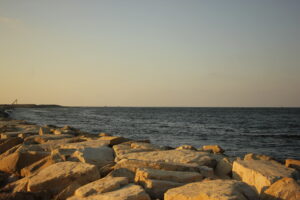Rosetta
Rosetta (Rasheed).
Rosetta, referred to in Egypt as Rasheed, is famous for the discovery of the Rosetta stone, which made deciphering hieroglyphics possible. Due to the strategic position of Rosetta, where the Nile meets the Mediterranean Sea, it became an important trade centre throughout Medieval and modern history. Many mosques, caravanserai and houses are witnesses to the prosperity of the Medieval city. It is a tranquil place with extensive gardens, orchards, and date palm plantations. Highlights include the Rosetta National Museum, formerly the governor’s residence, and taking a walking tour of the old market. Visit QaitBay Fort, built in 1479 to guard the meeting point between the Nile and the Mediterranean Sea, and Abu Mandour Shrine, dedicated to a local Muslim saint and a pilgrimage site for many of the locals.
The city covers an area of roughly 92 square kilometers or 9200 hectares.
In 1517, under Ottoman rule, Rosetta became a prosperous trading harbour. The city attracted the attention of both Britain and France, which were major colonial powers that controlled trade between Europe and the East.
As a result, Rosetta turned into one of the most flourishing Mediterranean harbours. Its warehouses were replete with grains, coffee, silk, and many other trading commodities, and its streets were bustling with rich merchants, consuls of European countries, as well as Armenian, Turkish, Syrian and Jewish traders. In addition to all this, many elegant hotels, mosques, churches, houses, and inns were built.
The town itself is an open museum, with 22 monumental residences dating back to the Ottoman Era, in addition to 12 mosques, mills, castles and public baths. It is a tranquil and highly green town with vast gardens, orchards, and date-palm plantations.
What to see:
Built-in the traditional Delta style using small, flat bricks painted alternately red and black, the Ottoman houses reflect a skilled style of architecture, construction and carpentry. Designed to match the Islamic architectural style, the houses comprise vast reception rooms, decorative, in-laid sea shell woodworks, domes and densely ornamented doors. The interior of the house was rich with exquisite decorations, including inscriptions in Kufic calligraphy. Some of the houses also have Mushrabiyyas (oriels), which were made of geometrically shaped fine wood. There are around 22 houses, most of which are being restored there are, however, a few are open for visitors. These include the Asfour, Abu Shaheen, Ramadan, and Amasyali Houses.
There are 12 historical mosques, but there are 3 particularly interesting mosques: Al- Mahali Mosque (1721 AD) has a ceiling supported by 99 columns from ancient Alexandrian monuments, Zaghlul Mosque is the oldest Mosque in Rosetta (1577 AD), and Abbasi Mosque (1809AD) is the most beautiful mosque in Rosetta, its façades decorated with molded bricks as the façades of the old houses of the city. The Al- Mahali, and Zaghlul mosques are important mosques to see, both recently refurbished.
Fort of Qaitbey was built in 1479 to guard the mouth of The Nile. It was at this spot that the famous Rosetta stone was found.
One of the most extraordinary buildings, the Azouz Bath (Hammam) is a 400-year-old bathhouse, which was still in operation even in 1980, using water pumped in from The Nile. It features a fine marble interior with elaborately carved wooden ceilings.
Abu Mandour is an old shrine dedicated to a local Muslim Sheikh, built on a spur in the Nile Branch South or Centre of Rosetta. It has been a pilgrimage site for many of the locals and a good place to meet local people and begin to understand the local culture.
The Arab Killi House and Rosetta National Museum, formerly the governor’s residence, is now the home of the city museum. It shows the history and the culture of the city through its exhibitions.
Built-in the 13th century AD, The Abu Shaheen Mill is a double mill turned by horses, for grinding grains.
Rosetta Mouth is where the Rosetta Nile branch meets the Mediterranean Sea.

